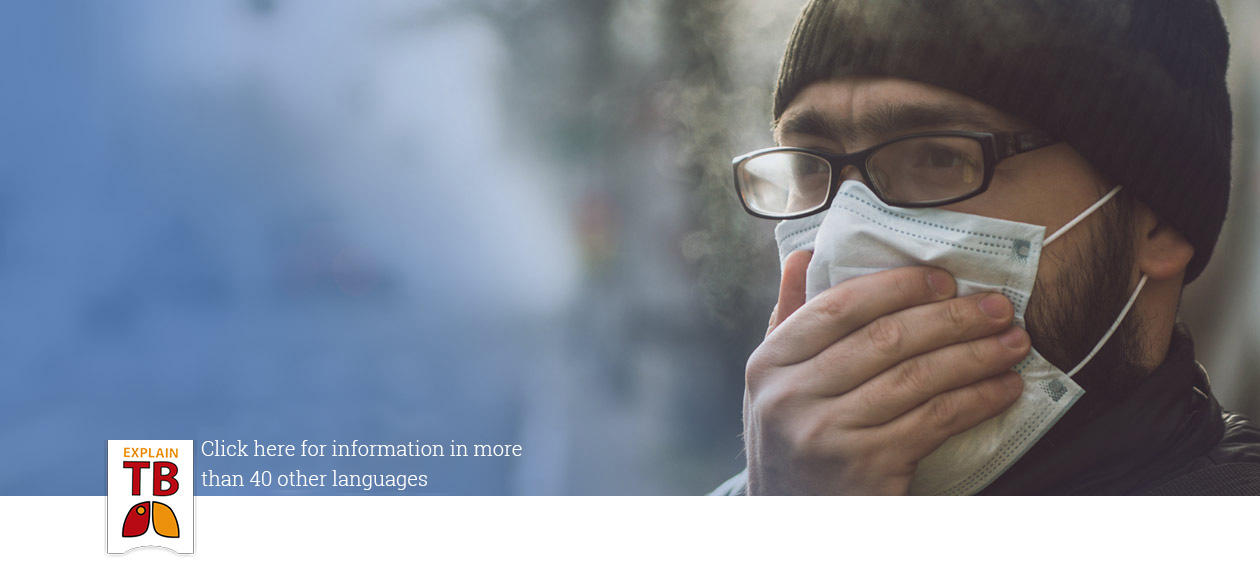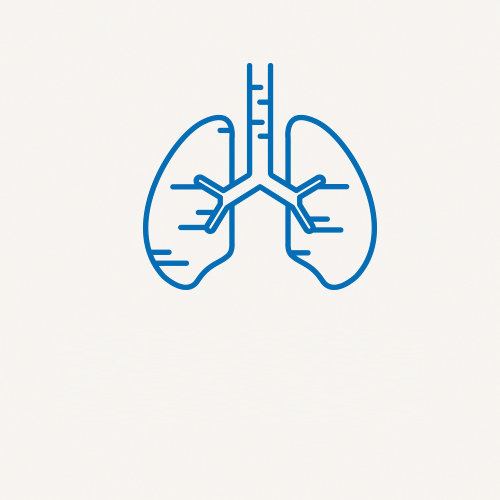Frequently asked questions about tuberculosis. (FAQs)
Diagnosis
Why does a person suffering from tuberculosis need to be isolated?
As long as tuberculosis is contagious, special measures are applied in order to protect other people from tuberculosis infection. In most cases, the treatment of infectious tuberculosis diseases is started in hospital. There, the affected persons are accommodated in a room separated from others (i.e. isolated) until the tuberculosis is no longer contagious. This is often the case after only a few weeks of effective treatment. If tuberculosis is still contagious, all visitors must put on mouth and nose protection whilst in the room together with the affected person. In this way, infection can be prevented. Affected individuals should also wear mouth and nose protection in order that fewer pathogens are released into the environment when they cough. Though, patients can leave their room (e.g. to go to an examination) even if they are still contagious. In this case, however, they must always wear mouth and nose protection as long as they are contagious. In order for the mouth and nose protection to prevent the spread of tuberculosis, it has to be applied correctly. A doctor or nurse can explain the correct handling and assist in putting on the mouth and nose protection.
last updated April 2018
Why do I have to be X-rayed?
Tuberculosis mostly affects the lungs. The X-ray examination is one possibility to determine whether a lung is affected by tuberculosis. The X-ray image can also visualise damage to the lungs, typically in the form of inflammatory areas (infiltrates) or small cavities (caverns). However, tuberculosis can also appear atypically in the lungs. The X-ray image must always be evaluated by specialists. In some cases, other examinations (e.g. computer tomography, bronchoscopy, or ultrasound) are necessary. At the same time, the sputum is always examined for tuberculosis bacteria.
In the course of the treatment, the X-ray examination is repeated at certain intervals in order to detect improvements or worsening of the disease. To X-ray the lungs, the patient is placed in front of an X-ray screen and must hold his/her breath for a short time after deep inhalation. The picture works best when the lungs are completely filled with air. X-ray of the thorax with a modern X-ray machine only produces very little harmful radiation.
last updated April 2018
What is the lab examining in my sputum?
If there is a suspicion that someone has tuberculosis, the coughed up sputum must be examined. The sputum must be coughed up from the deeper parts of the lung; saliva from the oral cavity cannot be examined for this purpose. The sputum is collected in a medical container and must be sent to the laboratory as quickly as possible. The laboratory can’t use samples from the previous day. If ones cannot spontaneously provide sputum, it may help to inhale with saline solution. This often helps to loosen the mucus in the lungs so that it can be coughed out.
If there are enough tuberculosis bacteria in the sputum, these can be made visible under the microscope by a special staining. Using a simple molecular genetic analysis, the laboratory can quickly determine whether the bacteria in question are tuberculosis or other non-infectious bacteria known as non-tuberculous mycobacteria. If tuberculosis bacteria can be seen under the microscope or detected by molecular tests, it is an infectious disease. In order to determine further characteristics of the bacteria, they are cultivated in the laboratory and subjected to certain tests. This bacterial culture can detect even smaller amounts of tuberculosis bacteria. However, the culture can take several weeks because tuberculosis bacteria grow relatively slowly. In order be able to start a tuberculosis therapy as quickly as possible, the results of microscopic and molecular examinations are usually sufficient. The sputum is examined at regular intervals during therapy in order to monitor the success of the therapy. If the laboratory is unable to detect any more bacteria in the sputum, the disease is usually no longer contagious. However, the treating physician must ultimately decide, whether the tuberculosis can still be contagious.
last updated April 2018
What is a computed tomography (CT) or layer X-ray?
In some cases, a computer tomography (CT) is necessary in order to assess changes in the lungs or other parts of the body more accurately. For this purpose, the patient must lie in an open apparatus for a few minutes so that a series of X-rays can be taken. It is important to lie still during the examination and to hold your breath when asked to do so. A contrast agent may be injected into the bloodstream in order to improve the quality of the image. You must then bring up-to-date blood values for the kidney and thyroid gland function. The contrast agent can only be well tolerated if both organs work sufficiently. Because the radiation exposure from a CT is somewhat higher, an X-ray image is usually taken first. It can then be decided whether an additional CT is necessary. In some cases it is sufficient to take CT images with a low dose of radiation (low dose CT).
last updated April 2018
Why is a bronchoscopy performed?
If the examination of the sputum does not allow a conclusive diagnosis of tuberculosis, a bronchoscopy may be necessary. It can be used to extract mucus, respiratory fluid, and small tissue samples from the deep respiratory tract. The samples are then examined in the laboratory. During the bronchoscopy patients receive medication so that they are not awake. After bronchoscopy, sore throat, temporary hoarseness, coughing with small amounts of blood, nosebleeds, or fever may occur. A bronchoscopy is performed in the hospital as an in-patient or out-patient procedure. The attending physicians must decide whether an out-patient examination can be considered.
last updated April 2018
Why is HIV testing recommended for people with tuberculosis?
Not every tuberculosis patient has HIV. However, those infected with HIV get tuberculosis much more easily because their immune system is weakened. The World Health Organization (WHO) therefore recommends that every patient with tuberculosis should be tested for HIV. An HIV infection is well treatable, and HIV medication today is generally well tolerated. This anti-retroviral therapy (ART) is able to suppress the HI virus so that it can no longer be detected in the blood. In most cases, ART also improves the function of the immune system. That is why HIV treatment supports tuberculosis therapy. It is therefore particularly important for people with tuberculosis to know whether they are HIV-positive and, in this case, to treat the infection. Today it is assumed that a treated HIV infection should not have a negative impact on either the quality of life or life expectancy.
last updated April 2018
What is (drug-) sensitive tuberculosis?
Tuberculosis bacteria should be examined in laboratory. In case the examinations show that the drugs are effective against tuberculosis bacteria, the pathogen is sensitive to these drugs. First of all, the four drugs that are used as standard therapy are tested (standard therapy: isoniazid, rifampicin, pyrazinamide and ethambutol). If a pathogen is not sensitive to a drug, this drug is not effective and the pathogen is resistant against it. The laboratory tests are called resistance tests and are important in order to define the accurate therapy as soon as possible. In case of resistance, the therapy of tuberculosis can be more difficult, because the most effective standard therapy cannot be prescribed. Thanks to new genetic tests, the results of resistance testing are often available after only a few days.
last updated April 2018
What is (drug-) resistant tuberculosis?
Tuberculosis bacteria should be examined in laboratory. In case the examinations show that the drugs are effective against tuberculosis bacteria, the pathogen is sensitive to these drugs. First of all, the four drugs that are used as standard therapy are tested (standard therapy: isoniazid, rifampicin, pyrazinamide and ethambutol). If a pathogen is not sensitive to a drug, this drug is not effective and the pathogen is resistant against it. The laboratory tests are called resistance tests and are important in order to define the accurate therapy as soon as possible. In case of resistance, the therapy of tuberculosis can be more difficult, because the most effective standard therapy cannot be prescribed. Thanks to new genetic tests, the results of resistance testing are often available after only a few days.
A drug resistance can be developed in case of treatment combination is not taken completely, not over the recommended period of time or in the wrong dosage. The instructions of the physician should therefore be adhered to. A resistant tuberculosis can also be contracted, if somebody is infected with tuberculosis bacteria that are already resistant.
last updated April 2018
Interviews with experts and patients.



















